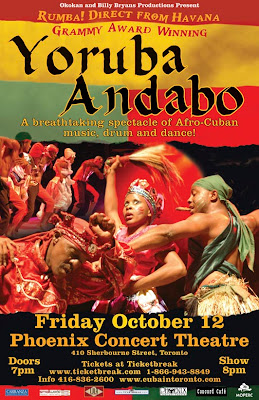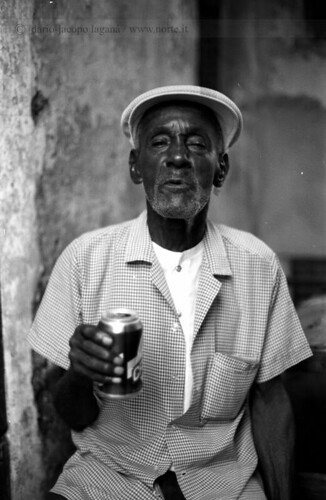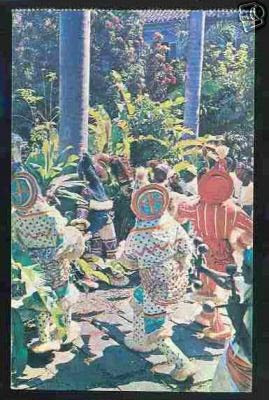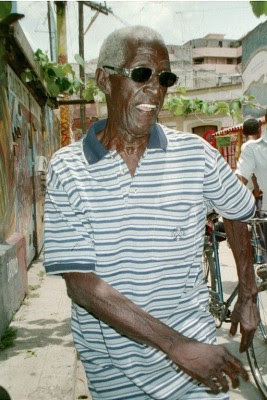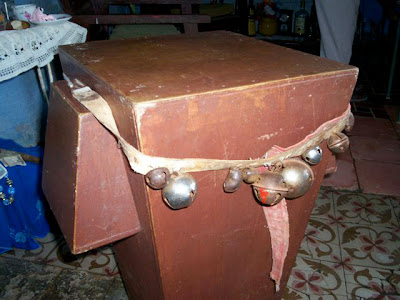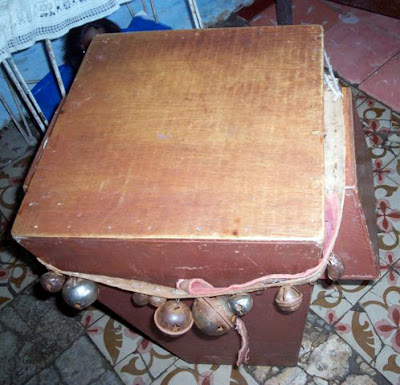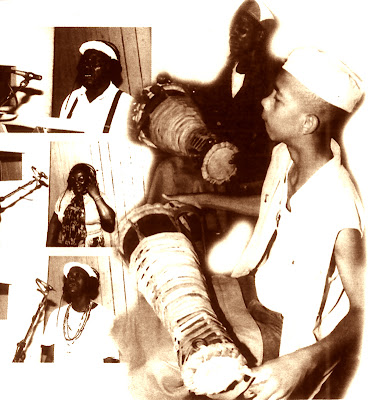Wednesday, December 05, 2007
Ibae: Carlos "Patato" Valdés
Carlos "Patato" Valdés passed away last night and the tributes to this influential master will be many and well-justified.
His achievements were numerous, but around here he will always be remembered most for his 1967 recording "Patato y Totico," one of the all-time great rumba recordings. If you don't have it, get it. If you have it already, put it on and enjoy.
Also be sure to visit Martin Cohen's excellent photo tribute to Patato.
Posted by
Barry
at
1:17 PM
6
comments
![]()
Labels: Rumberos
Thursday, October 18, 2007
New from Oba-Ilu
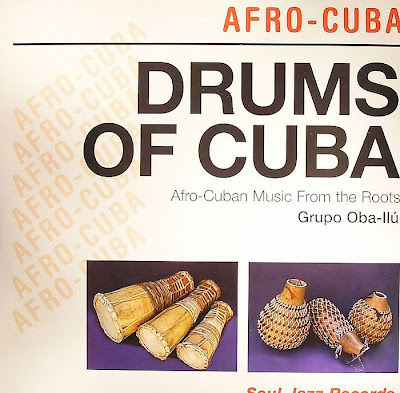
New on Soul Jazz Records. Seems like an overview of the rhythms, no songs included. Should appeal to all you drumaholics out there.
Track List:
| 1. | Elegua (Latopa) | |||
| 2. | Oggun | |||
| 3. | Ochosi (Aguere) | |||
| 4. | Chango (Bayuba) | |||
| 5. | Oya:Abakua (Tuitui) | |||
| 6. | Agayu:Toque (Chango-Rumba) | |||
| 7. | Yuka | |||
| 8. | Makuta | |||
| 9. | Palo | |||
| 10. | Bembe | |||
| 11. | Guiro | |||
| 12. | Iyesa (Variant 1) | |||
| 13. | Iyesa (Variant 2) | |||
| 14. | Arara (Variant 1-Mase) | |||
| 15. | Arara (Variant 2-Soyi) | |||
| 16. | Arara (Variant 3-Gervioso) | |||
| 17. | Abakua | |||
| | ||||
Have a listen and buy the LP, CD, or even mp3s here.
Posted by
Barry
at
1:38 PM
12
comments
![]()
Sunday, September 30, 2007
Yoruba Andabo Touring Canada October 2007
Posted by
Barry
at
9:19 PM
0
comments
![]()
Labels: Yoruba Andabo
Wemilere and "Ven Tu, Rumbero"

We wanted to bring your attention to this undeservedly obscure disc some of you may have missed, "Wemilere."
Recorded in 1998 and not released until 2003 on the French Long Distance label, the disc has a loose, experimental feel, yet stays firmly rooted in tradition. Many tracks incorporate a fusion of disparate afro-cuban styles, resulting in such "inventos" as "Abakuá-Batá-Rumba."
Despite who you see pictured on the cover, the personnel on this recording are:
Román Díaz Anaya: Musical director, batá iya,congas, vocals
José Fernandez Hernández: Director, batá itotele, congas
Angel Gonzales Vila: Quinto
Orlando López Alonzo: Vocals, dance
Pedro Martínez Campos: Vocals, batá itotele, congas
Antonio (Tonito) Martínez Campos: batá okonkolo, catá
Jesus Lorenzo Peñalver "Cusito": Vocals, batá iya on "No sé"
On the origins of the group and it's association with Mario Dreke "Chavalonga", Román Diaz writes:
"After Pancho Quinto recorded his "En el Solar la Cueva del Humo, " he started a project called "Los Cinco Solitos" consisting of Pancho Quinto, Ricardo Gomes Santa Cruz, Pedrito Martinez, Toñito Martinez, and myself. We did some shows and made some recordings, and [Canadian saxophonist] Jane Bunnet became interested in the project. At her suggestion, Amado Dedeu and Ernesto "El Gato" Gatell were brought in as well.
However, at this time Pancho started working on his second disc (Rumba Sin Fronteras), with [singer] Octavio [Rodriguez], El Negro Triana and Lázaro Rizo, and the organizers decided to select a touring group for Pancho's commitments in the USA and Canada, so Tonito, Ricardo Santa Cruz and I stayed behind.
It was at this point "Wemilere, Phase One" came into being, with José Fernandez, Pedrito Martínez, Tonito and myself, produced by Alex Romaron and at the engineering console, Ramón Alom.
Then when Pancho came back, we began Phase Two of Wemilere, with recordings by Santa Cruz and Cusito [Jesús Lorenzo Peñalver], Angel Vila and Orlando El Bailarín. Puntilla also was present for this second phase along with the legendary Pluma and the masters of Abuaká songs Rafael and Moran.
Then came the first phase of Ven Tu, which came from an idea suggested by
LA CASA DE CULTURA DE CENTRO HABANA for EL FESTIVAL
DE LA RUMBA, with shows at the Teatro America, and on Radio Progresso, recordings with Lázaro Rizo, El Negro Triana, Orlando, and Celestino Fariñas, who was selected to take Ven Tu Rumbero to the Maestro Chavalonga.
When Chavalonga joined, the group unanimously agreed to call itself Chavalonga y El Ven Tu, as a sign of respect to Mario Dreke, and with the help of Felix Reyes, Director of the Comparsa La Bollera, from the Los Sitios neighborhood.
Recently youtube user jicamocubano has begun posting some excellent historic video of this group. We are posting one of our favorites below. You can go here to see all jicamocubano's videos.
Besides Román on tumba, the video includes Tonito on tres dos, Angel Vila on quinto, Lázaro Rizo (guagua and vocals), Guillerme "El Negro" Triana (clave and vocals) Mario Dreke "Chavalonga," (vocals). Rumba doesn't get much better than this. Enjoy.
Posted by
Barry
at
11:25 AM
3
comments
![]()
Tuesday, September 25, 2007
Ibae: Esteban "Chachá" Vega Bacallao
We are a little late posting the sad news of Chachá's passing, but we've stumbled on some new items that people have shared on the web so we wanted to pass them on.
First is the photo above from user Norte_it at flickr.com.
Second is this great interview (and his last) graciously posted by Tina Gallagher of Kabiosile Productions. Ibae, Chacha.
Posted by
Barry
at
6:51 AM
3
comments
![]()
Labels: Los Muñequitos, Rumberos, Video
Tuesday, August 28, 2007
45th Anniversary of the Conjunto Folklorico Nacional
Back in July, we posted a full scan of the program from the début performance of the Conjunto Folklórico Nacional (which you can find here).
Well thankfully that wasn't enough for our own truly indefatigable and lovably obsessive over-achiever Patrice Banchereau, who was inspired to start a full-blown blog in tribute to the momentous occasion: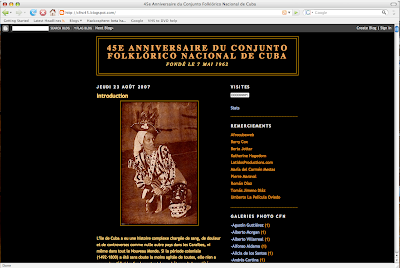 It's in French, but even if you don't understand the language we're sure you'll find plenty there to keep you entertained for a long time. He's included every photograph and all text from the program, plus posters, video, and photo galleries dedicated to members past and present of the Conjunto. Really an astounding work and an invaluable resource.
It's in French, but even if you don't understand the language we're sure you'll find plenty there to keep you entertained for a long time. He's included every photograph and all text from the program, plus posters, video, and photo galleries dedicated to members past and present of the Conjunto. Really an astounding work and an invaluable resource.
He also has a section with photos of members he is still trying to identify, called "¿Pero Quien Son Esa Gente?" so take a look and if you recognize anyone, drop him a line.
Posted by
Barry
at
6:16 PM
2
comments
![]()
Labels: Conjunto Folklórico Nacional
Monday, August 27, 2007
Voice of the Leopard: Ned Sublette and Ivor Miller on Abakuá
This came today from Ned Sublette:
Earlier this month I sent out a transcript of an interview I did in the
process of producing "Voice of the leopard" -- an episode of afropop
worldwide's hip deep with Dr. Ivor Miller about his work with Abakuá in Cuba
and Ekpe in Calabar.
For those who are interested, the program we made is now up and streaming at
http://www.afropop.org
It's an incredible story, and the music's great.
Posted by
Barry
at
8:50 AM
0
comments
![]()
Labels: Abakuá
Wednesday, August 15, 2007
Left Hand Clave; Right Hand Quinto
After a brief hiatus, our friend Antoine Miniconi has started posting regular updates, including videos for download, to his site dedicated to those kings of guarapachangueo, Los Chinitos.
Here is a nice bit of Piri practicing a little exersize playing quinto with his right hand and clave with his left...don't try this at home!
More at http://www.apozo82.blogspot.com/
Posted by
Barry
at
3:34 PM
2
comments
![]()
Labels: Los Chinitos
Friday, August 03, 2007
Carlos Embale: El Edén de los Roncos and "Consuélate como yo"
 Carlos Embale
Carlos Embale3 August 1923 — 12 March 1998
(Photo: Leonel Constantino)
He got his break at 13, winning a spot on the old "Corte Suprema del Arte" radio program, but he didn't start singing rumba professionally until much later. As he told Maria del Carmen Mestas:
"A fines de 1954, Piñeiro, Urfé y Ortiz me hicieron como una especie de complot para que yo cantara guaguancó, porque hasta estos momentos lo que más hacía eran boleros, canciones y el son. Yo sabía muchas rumbas porque tenía un hermano [Luis Embale] que murió joven, que cantaba como nadie el guaguancó; he conocido destacados intérpretes de esa música, pero como Luis ninguno; es lástima que su voz, como la de Pedro Quevedo, no quedara grabada..." (de "Pasión de Rumbero," María del Carmen Mestas)
(My translation:)
At the end of 1954, [Ignacio] Piñeiro, [Odilio] Urfé and [Rafael] Ortiz sort of conspired to get me to sing guaguancó, because up until then I mostly did boleros, canciones, and sones. I knew many rumbas because I had a brother [Luis Embale] who died young, that sang guaguancó like no-one else. I've known many well-known interpreters of this music, but nobody like Luis. It's a shame that his voice, like that of Pedro Quevedo, was never recorded..."Reading this, I'm always left pondering our great loss that we'll never hear Luis or Pedro.
Fortunately for us, Carlos' inimitable voice was recorded. (Check out "Rumbero Mayor" and our compilation of unreleased-on-CD Embale tracks, here.)
We are also fortunate to have a couple of videos to share today. The first one features Carlos singing "El Edén de los roncos" and "Consuélate como yo" which he dedicates to its author, Gonzalo Acensio, "Tio Tom."
EL EDEN DE LOS RONCOS
Compositor: Ignacio Piñeiro
Estilo: Guaguancó
Cuando tú, tu desengaño veas
De tantas ilusiones vanas que te alientan
Buscarás los lugares más oscuros
Para poder llorar a solas tantas penas
Mientras yo al verte adolorida y triste
Le cuento al mundo mis hazañas nuevas
Y a ti, te digo nena linda no te atrevas
A provocar más nunca
La ira de Los Roncos
Ah, de Los Roncos, ¡óye!
Coro: Ven a gozar, pinareña ven
CONSUÉLATE COMO YO
Compositor: Gonzalo Asencio
Estilo: Guaguancó
Pero consuélate como yo
Que yo también tuve un amor
Y lo perdí
Y por eso digo ahora
Ya yo no vuelvo a querer
¿De qué te sirvió el querer?
Si a ti el amor te traicionó
Como a mí
Coro: Por eso ahora, ya yo no vuelvo a querer
The second video is a compilation of short clips from the same session, but found in two different documentaries. One from "La Rumba" (1974, Oscar Valdés) and the other from a documentary which aired on Greek television. A very short segment, but a smoking hot rumba.
Posted by
Barry
at
12:27 AM
1 comments
![]()
Labels: Carlos Embale, Video
Saturday, July 28, 2007
Gene Golden's "Quinto Mayor": Compay Galletano
Here's a nice guaguancó from Gene Golden's group, "Quinto Mayor," recorded in NYC 2006.
Featuring
Gene Golden
Roman Diaz
Skip Burney
Puntilla
Pedrito Martínez
Frank Bell
Xiomara Rodriguez
Enjoy.
Thanks to Patricio for the lyrics:
Compay Galletano
Compositor: Desconocido;
Estilo: Guaguancó;
Cantan: Orlando “Puntilla” Ríos & “Pedrito” Campos Martínez
Ya Compa’ Galletano
¿Como sin diente va a mole’?
(bis)
Waí waí waí ila so
Waí waí waí ila so
Waí waí waí ila so
Kó kó wa mole’
Waí waí waí ila so
Waí waí waí ilaso
Waí waí waí ila so
Kó kó wa mole’
Un pa’ kiti Mamá
Un pa’ kiti Papá
Kó wa ne da ikó-o
Ma ilé o…
Un pa’ kiti Mamá
Un pa’ kiti Papá
Kó wa ne da ifó-o
Ma ilé o…
Un pa’ kiti Mamá
Un pa’ kiti Papá
Kó wa ne da ikó-o
Ma ilé o…
Un pa’ kiti Mamá
Un pa’ kiti Papá
Kó wa ne da ifó-o
Ma ilé o… (de un canto de Tumba Francesa)
Solista: Pero kó kó ka íña-a
Coro: Ma ni Lodó, ma ikokó ka íña
Posted by
Barry
at
7:49 PM
3
comments
![]()
Virgilio Martí singing "Más Que Nada"
Here's some rare footage of the great Virgilio Martí, singing his classic version of Jorge Ben's "Más Que Nada," which he recorded on "Patato y Totico" (an indespensible record and recently remastered, by the way.)
This is from a 1979 performance at the Schomburg Center for Research in Black Culture. The group was called "Afrocuban Fantasy" and featured:
Virgilio Martí: Vocals
Little Ray Romero: 3/2
Gene Golden: Tumbadora
Eloy Martí: Quinto
Xiomara Rodriguez: Dancer
Eddie ?: Dancer
The coro includes:
Pedro Morejón
Carlos Sánchez
Russell Burroughs
Thanks to our friend Gene Golden for sharing this with us. Enjoy.
Posted by
Barry
at
3:39 PM
3
comments
![]()
Labels: Video, Virgilio Martí
Wednesday, July 25, 2007
Conjunto Folklórico Nacional: Début Program

Today is the 44th anniversary of the début performance of The Conjunto Folklórico Nacional, July 25 1963. To commemorate, we are pleased to present a full scan of the original catalog for the performance. Our thanks to Román Díaz and Berta Jottar for sharing this historic document with us.
Besides the articles written by Rogelio Martinez Furé, the book also contains many historic photographs of such notables as Carlos Aldama, Lázaro Ros, Jesus Pérez, Trinidad Torregrosa, Nieves Fresneda, Luis Chacón, Ricardo Gómez Santacruz, and more. Patricio is working on restoring some of the portraits and we hope to begin posting them in the very near future. In the meantime, here are some sample pages. Click for a larger view.


Download the full 68-page program in pdf format (18MB) here.
UPDATE June 2009: Added to scribd.com
cfncatalog
Posted by
Barry
at
8:51 AM
1 comments
![]()
Labels: Conjunto Folklórico Nacional
Wednesday, July 18, 2007
Celia Cruz from "Affair in Havana" (1957)
Celia Cruz passed away July 16 2003. Here is a clip of her from the 1957 film "Affair in Havana." Can anyone identify the other percussionists?
Posted by
Barry
at
9:08 AM
2
comments
![]()
Labels: Celia Cruz, Regla de Ocha (Santería), Video
Friday, July 06, 2007
Yoruba Andabo: Guantanamera
Yoruba Andabo in a classic performance of their brilliant version of "Guantanamera," which is more like a version of José Ramón Sánchez's "El Madrugador" with Joseito Fernández's famous coro. Enjoy.
Guantanamera
Autor: Joseito Fernandez / José Ramón Sánchez
Grabación: Yoruba Andabo, "Del Yoruba al son"
Yoruba Andabo les canto
Y Uds se lo pedian
A Joseito Fernández
El rey de la melodía
A Joseito Fernández
El rey de la melodía
Guantanamera
Guajira guantanamera
Guantanamera
Guajira guantanamera
(bis)
Que lindo es el suelo mío
Bajo el azulado cielo
(bis)
Que juntito al arroyuelo
Murmurar junto al bohío
Guantanamera
Guajira guantanamera
Guantanamera
Guajira guantanamera
(bis)
Ilumina el vergelillo
El sol con su claridad
Y rompe la soledad
Habitual de las praderas
Una tondada siquiera
¡Qué signo de libertad!
Guantanamera
Guajira guantanamera
Guantanamera
Guajira guantanamera
(bis)
A mi la canción me inspria
Por su romántico sello
(bis)
Pero se admirar lo bello
De una tonada guajira
Mira de un bardo
Bardo la lira
Como el sol en
Como el sol en la mañana
Más la doctrina
La doctrina martiana
Con la mente se demuestra
Cantando música nuestra
Que es más linda
Y es cubana
Guantanamera
Guajira guantanamera
Guantanamera
Guajira guantanamera
(bis)
Solista: Lo cantaba Joseíto en La Republica entera
Coro: Ya tienes mi guaguancó
Guajira guantanamera
Coro: Guajira guantanamera
Posted by
Barry
at
6:34 PM
0
comments
![]()
Labels: Video, Yoruba Andabo
Thursday, June 28, 2007
Afrocuba de Matanzas: 50 years of "Folclore Matancero"
Grupo Afrocuba de Matanzas was founded 50 years ago tomorrow, June 29, 1957. Let's celebrate with a video of this classic performance of their Batarumba style, featuring Teresa Polledo, Saldiguera and Virulilla.
PALO YAYA
(Francisco Dominguez)
Yo soy rumbera
Desde que estaba
En el vientre de mi madre
(bis)
Me dijo un congo
Me dijo un congo
Palo que nace pa’ violín
Desde que está en el monte suena
(bis)
Desde niña soy cantora
Voy cantando doquiera
Canto con Saldiguera
Y canto con él que sale
Yo canto con Carlos Embales
Eminente en guaguancó
Y por eso yo le digo
Yo soy rumbera
Desde que estaba
En el vientre de mi madre
Coro: Palo que nace pa’ violín
Desde que está en el monte suena
Coro: Ah, ah, ah, yo soy Palo Yaya
If you haven't already, be sure to get the collection of 12 ACdM rarities we posted here.
More videos can be found on Afrocuba's website.
Posted by
Barry
at
7:44 AM
0
comments
![]()
Labels: Afrocuba de Matanzas, Lyrics, Video
Saturday, June 23, 2007
Los Muñequitos, on the BBC
Reader Rob A. from Brighton sent us this email yesterday:
Hello Guarachon,
Firstly, thankyou so much for your great work in posting so many rare vids and recordings etc. your blog and youtube account are an invaluable resource.
I was wondering if you knew about a BBC radio3 programme aired last Saturday called World Routes? The presenter, Lucy Duran, was looking at the musical history of Cuba, and visited Matanzas to do pieces on Rumba and Danzon.
She visited Los Munequitos de Matanzas and specially recorded 2 Rumbas with the group and an interview with Diosdado Ramos Cruz and Juan Jacomino.
You can listen to the whole programme as a stream online, but only until Saturday (about 24 hours away)
I have, however, ripped the whole 1hr show as an mp3. I would be willing to send you the whole show, but it is 78.5MB, and I don't know where i can post this for free (any suggestion appreciated).
I have separated out the 2 tracks and the interview and am sending them to you now. (There's not a huge deal more on rumba as it moves on to danzon pretty quick).
Actually we didn't know about that Rob, thanks a lot for letting us know and sending these in.
The recordings are very nicely done, we especially like the "a capella" ending they put on "Congo Yambumba" and I am curious to find out who the new singer is on the columbia.
Click below to listen to the columbia:
We've posted the mp3's (15.5MB) of the interview, Congo Yambumba, and the columbia excerpt for download from rapidshare, here.
Rob also adds:
This was the third episode of 3 covering the music of Cuba. I only found out about it after the third, so didn't get a chance to hear or record the other 2. maybe you could mention this in the blog and ask if anyone else recorded them, as i'd really like to hear the congas they recorded.
How about it? Anybody happen to grab those other episodes? Let us know.
Posted by
Barry
at
7:42 AM
2
comments
![]()
Labels: Los Muñequitos, Music downloads
Friday, June 15, 2007
Chavalonga: Palo Quimbombó
More Chavalonga, doing "Palo Quimbombó" at Parque Tio Tom in Atarés. Also some nice footage of Chava jamming with the neighborhood kids afterwards. Many thanks to Lisa Knauer for sharing this with us.
PALO QUIMBOMBÓ
Compositor: Mario Dreke
Estilo: Guanguancó
Grabación: Mario Dreke, "Rapsodia Rumbera"
¡Dio' Mambe!
¡Dio!
¡Dio' Mambe!
¡Dio!
¡Nsala malekun!
¡Malekun Sala!
¡Nsala malekun!
¡Malekun Sala!
¡Yo engaño ko jura’ mi nganga kuna chila!
¡Yo son bacheche arriba n’toto!
¡Yo son bacheche arriba n’ganga!
¿Qué te pasa a ti?
¿Qué te pasa a ti?
Que es como el quimbombó
Que resbala
Pero ponte en tu lugar
Luego ponte a analizar
Que palo quimbombó
No sirve pa' candela
Amayo e, amayo e, arawe arawe
Amayo e, amayo e, arawe arawe
Coro: Palo quimbombó no sirve pa' candela
Coro: Quimbombó
Posted by
Barry
at
7:49 AM
1 comments
![]()
Labels: Video
Friday, June 08, 2007
More Chavalonga Videos
Here are a couple more videos of Chavalonga, from documentaries aired on Greek TV. Thanks to Patricio and Carole for these.
Posted by
Barry
at
9:50 AM
1 comments
![]()
Monday, June 04, 2007
Chavalonga: Cuando se pierde un amigo
Sadly it seems the reports are true, Chavalonga has passed away. We are grateful to our friend Roman Diaz for sharing this recording of Chavalonga singing "Cuando se pierde un amigo," ("When one loses a friend") with the group "Chavalonga y El Ventu Rumbero."
Maria del Carmen Mestas quotes Chavalonga on the inspiration for "Cuando se pierde un amigo":
"Se podrá pensar que sólo me dediqué al fiesteo, mas no fue así; me dolían las injusticias, por eso me fui a aquello de Cayo Confite a tumbar al déspota Trujillo. Yo era capitán de un barco que llevaba armas; me atraparon en Puerto Príncipe. En ese viaje tuve una experiencia muy dura: la muerte en una pelea de Jesús Alfaro, Mejoral. La emoción me llevó a inspirarme: "Cuando se pierde un amigo..."
"One could think that I spent my life partying, but it isn't so: Injustices affected me, that's why I went to Cayo Confite to topple the dictator Trujillo. I was captain of a ship which carried arms: they caught me in Puerto Príncipe. On this trip I have a very bad experience: the death in a fight of Jesús Alfaro, "Mejoral." The emotion inspired me to compose, "Cuando se pierde un amigo..."
Roman sends along this message:
LA RUMBA ESTA MORTIFERA
DIJO EL CURVO
A KIKE CUANDO LO VIO LLEGAR
Y EL CHORI EMOCIONADO
EL QUINTO A PANCHO PIDIO
CALLAVA CON MALANGA
ENTONABAN SU RUMBON
CUANDO SE ESCUCHO ESTA VOZ
PALO QUIMBOMBO NO SIRVE PA CANDELA
CHAVA ABRAZO A MANUELA
YAMBU PALO MARIBA
EL IMPERIO CELESTE
— Roman Diaz
(Guillermo "El Negro" Triana starts out the song, then Chava comes in.)
CUANDO SE PIERDE UN AMIGO
CHAVALONGA y EL VENTU RUMBERO
Pero cuánto te quiero
Cuánto te adoro
Mi amigo del alma
Nueva idea
Que Dios te bendiga
Yo quiero que mis cantares
Nacido del corazón
(bis)
Los acepte como una prueba
De mi amor hacia ti
Y que nunca me olvides
A na na na...
Cuando se pierde un amigo
Que tristeza
Que dolor se queda
En el alma
Si hoy te canto a tí
Te diré porque
Yo tuve un amigo fiel, "Mejoral"
Y lo perdi
Que me confiava sus penas
Y yo las mias
Era mi amigo
Por la señal
De la Santa Cruz
De nuestros enemigos
Líbranos Señor
Amen, Jesús
Recorded by Ramon Alon
at Danny Puga's studio
Reparto Mañana, Guanabacoa
La Havana 1999
Personnel:
MARIO DREKE "CHAVALONGA"
GUILLERMO "EL NEGRO" TRIANA
PEDRO CELESTINO "FARIÑAS"
ROMAN DIAZ
LAZARO RIZO
MATEO "EL SUIZO" (Mathieu Zehnder)
"EL MORO"
AVENIDA
CUSITO (Jesús Lorenzo Peñalver)
ORLANDO "EL BAILARIN"
JOSEITO (José Fernández Hernández)
ANGEL VILA
TONITO (Antonio Martínez Cámpos)
Download Chavalonga singing "Cuando se pierde un amigo" here.
Posted by
Barry
at
10:27 AM
1 comments
![]()
Labels: Music downloads, Rumberos
Saturday, June 02, 2007
Homenaje: Mario Dreke Alfonso, "Chavalonga"
We heard from El Goyo today (June 02, 2007) this sad news:
"Hoy a 4a.m falleció Mario Dreke Alfonso ( Chavalonga )."
("Today at 4 am Mario Dreke Alfonso "Chavalonga" passed away.")
We will be writing more about Chavalonga once we can confirm the news, in the meantime we'll take a moment to reflect on the work of this great rumbero.
Most readers will be familiar with him from his classic performances on "Rapsodia Rumbera," especially "Palo Quimbombó." He also released his own album on the Envidia label, "El rey de la Tahona."
He also led the groups "Ven Tu, Rumbero" (also known in another incarnation - without Chavalonga - as "Wemilere") and "Agüiri Yo."
Helio Orovio, in "Cuban Music A to Z," writes:
"Dreke, Mario ("Chavalonga"): Author, singer, dancer, musician. Born 25 April 1925, Havana. Since the 1940s Chavalonga has been considered one of the most outstanding performers of African rhythms and rumba. Among his most popular guaguancós are "Palo quimbombó," "Los barrios unidos," "Muñequita," and "Oye lo que te voy a decir." He was a founder of the National Folkloric Ensemble [Conjunto Folklorico Nacional] and is currently the director of a company carrying his name."
Maria del Carmen Mestas, a cuban writer who has done more than anyone lately to document the biographies of rumberos, published piece about him recently here. (The piece was adapted from the chapter on Chavalonga in her (highly recommended) book "Pasión de Rumbero."
Below is my translation of her article:
Memories of a rumbero
MARIA DEL CARMEN MESTAS
If you walk through the Havana district of Atarés it's possible you will see Chavalonga, a "street encyclopedia" of rumba. Chava, as his friends like to call him, has seen many moons pass in his tired heart, but if drum is heard he is the first one in dancing.
The night traveled in the light of thousands of stars. The scent of the leafy lemon tree competed with one of jasmins. Skinny, with a brilliant glance, the youngster entered the circle. The drums exerted their ancestral spell so that Chavalonga gave a skillful dissertation when dancing to a well-known guaguancó. It had not finished and even still many were applauding. "Avemaría! Yeah! He's fenomenal!" said the queen of jolgorio, Andrea Baró, with astonished eyes, while Carburo predicted, "Boy, you will be great!"
"Yes, back then in Jovellanos, Matanzas, I was consecrated", exclaims Mario "Chavalonga" Dreke proudly, one of our great rumberos, when remembering that happy beginning in a genre to which he has brought his creativity to dance, song and percussion.
A LIFE, A RUMBERO
Rumba has always accompanied Chavalonga, and together they've lived moments of great joys and others of secret pain. This mythical figure has worked the genre from its deepest root, giving it an expression uniquely his; that is to say, creating a style that identifies him.
It's certain that his first rumba was savored "very small, because as soon as I opened my eyes I heard the drum, and if to others they sang it to sleep with lullabies, mine was with that sound that can be as sweet as honey.
My family is from Limonar province in Matanzas, and when Christmas Eve arrived, everyone who could came to my house, to "the judgement," as the rumberos called it; the same
he appeared one of Carlos Rojas, who was from Jovellanos or Jagüey, and from different municipalities. So it was that I got started in this music, drinking from that which the stars made: Carburo, Sagua, El Dinde, Celestine Domec, Jimagua and others.
"That was my world since I was very small, and I love it because it's a part of my life that, by the way, was very risky. I couldn't exist without music because it is as if I lacked eyes to see or my voice to sing.
"I worked with Chano Pozo in a cabaret that was called... something like
Spotwind, and also in comparsas, that was our diversion. All year we were waiting for the carnavales to arrive and prepared ourselves by rehearsing.
With Chano I learned to play the drum; now I dance and sing with seven. He was a very guarachero type, happy, but the atmosphere dominated him and he took the wrong path.
"I participated in the film "Sucedió en La Habana," and I went to Mexico, where I acted in films with the comic actress Vitola [Famie Kaufman], but I became ill because the hot spices hurt me (I do not know if it was really that, or because I carried the weight of nostalgia in my heart). I came back on the boat "Lucero del Alba."
If someone has been in Chavalonga's memory it is Benny Moré, with whom I worked in the Molino Rojo and other places in the federal district. "Benny is always in my thoughts: a man who gave it all. His thing was to sing, to throw his wonderful voice to the wind... "
Creator of the Tahona rhythm and inspired composer of boleros in the guaguancó style, Chavalonga also appears in other films as "La última cena," "Rapsodia abakuá," the documentary about Tío Tom, "La rumbera" and "La historia del negro rumbero Mario Chavalonga."
Chavalonga is a founder of the Conjunto Folclórico Nacional, where he not only contributed his knowledge, he also extended his own to master other genres like the songs of the Yoruba, Lucumí, Arará, Carabalí...
With that famous group he traveled to many countries; the greatest successes of the rumbero were in Brazil, where he sang the prayer to Shangó and was highly applauded, and in Algeria, when we was inspired to compose the number "Los Gorritos."
Brother of another famous rumbero, Enrique Dreke, El Príncipe Bailarín, my friend Chavalonga doesn't stop playing the drum, dancing the best steps, and remembering his youth full of great rumbas.
We'll leave with this clip of an interview, from a documentary called "Para Bailar La Habana" which aired on Greek television:
Posted by
Barry
at
7:08 PM
0
comments
![]()
Labels: Rumberos
Sunday, April 08, 2007
Homenajes
Our friend Román Díaz sends us these photos:"ESTA FOTO FUE TOMADA RECIENTEMENTE EN LA TUMBA DE IGNACIO PIÑEIRO Y DE CARLOS EMBALES EN UN HOMENAJE ORGANIZADO POR INTEGRANTES DEL SEPTETO
NACIONAL Y RUMBEROS COMO CHANG EN LA FOTO JUNTO A FRANK OROPESA ADMINISTRADOR Y BONGOSERO DEL SEPTETO NACIONAL..."
"This photo was taken recently at the tombs of Ignácio Piñeiro and Carlos Embale in an homage organized by members of Septeto Nacional and rumberos such as Chan, in the photo with Frank Oropesa, current manager and bongosero for Septeto Nacional""...Y EN LA OTRA TENEMOS A FRANK OROPESA JUNTO A MININI DIRECTOR DE AFROCUBA DE MATANZAS CON MOTIVO DE ENTREGA DE MEDALLAS POR 50 AÑOS DE TRABAJO ARTISTICO."
"...and in this one we have Frank Oropesa with Minini [Francisco Zamora], director of Afrocuba de Matanzas, when they received medals recognizing them for 50 years of artistic works."
Thanks to Román for sending these in and congratulations to Frank and Minini for their achievement.
Posted by
Barry
at
8:51 AM
1 comments
![]()
Labels: Rumberos
Friday, March 23, 2007
Rumberos de Cuba : Habana de mi corazón
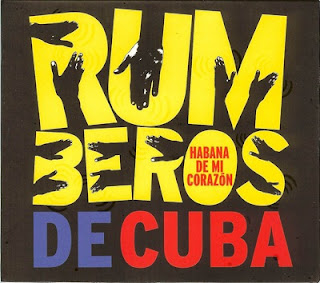
The new Rumberos de Cuba CD we first told you about here is out, and it is very good, but also not easy to find. I had to go to J & R Music, it's not listed on their website but you can probably order it from them by phone. There is a short documentary of the group included on the CD, I've posted a brief clip below, if you like what you hear on the soundtrack you will love the CD.
From Patricio:
What I'd like to add, as a big fan of Rumberos de Cuba, is that something really différent has occured with this new record.
"Old" singers have disappeared, though Luis Chacón and this guy I didn't know appear on the video (exit the two left Aspirinas: Miguel Ángel and Luis Chacón, who were only "guests")- the fact is I don't know Sofía's birthday (the yambú female singer who sings "Sikuini Bakuele" too).
Obviously, "Rumba con Sentimiento" is partly sung a duo by Ernesto and Ricardo Gómez Santa Cruz (guest or member?).
All other singers are young (Ariel, Cusito). A veces Ariel me recuerda Roberto Maza - he ain't got no sharp voice like rumberos usually have. Over-produced coro are present, like in any "new" rumba cd.
First time hearing has been a great emotion, as El Gato's voice, a few years later, seems more mellow yet, and contains even more emotion than before. Maybe (I'm quite sure that) his actual mood is reflected by his voice…
Second hearing gives me a bad feeling. All old timberos also disappear, now that Marquito is dead. The quinto player is supposed to be Maximino. The drums therefore seem to be more "tight", more "agressive", more "modern" too. They're loosing a bit of their ancient sabor - the same feeling that we get with the new Muñequitos style. Maybe I need a short time to listen to the record more carefully, and get used to the style changes.
I don't like very much Ariel's style of singing, and he's getting a more important place than before in the group… maybe it's just that. Se fueron los rumberos viejos, except Maximino (born 1939) and Ernesto (born 1946).
Rumberos de Cuba doesn't look like the All-stars it used to be any more. But the record is great stuff anyway.
Posted by
Barry
at
12:02 PM
1 comments
![]()
Labels: Rumba, Rumberos de Cuba, Video
Tuesday, March 13, 2007
7 Rarities from Los Muñequitos
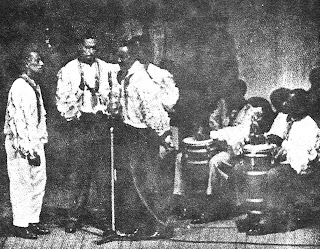 Guaguancó Matancero
Guaguancó Matancero(Los Muñequitos de Matanzas), probably late 50's—early 60's.
(Photo from "Generos de La Música Cubana" (1981) Olavo Alén Rodríguez)
I was certain that between those CDs and the ones in our "Old School Rumbas" post, there were no more of these recordings to be found. So you can imagine how pleasantly surprised I was when Patrice recently sent me 5 completely unknown (to me) tracks by Los Muñequitos.
We owe these tracks to the generosity of two individuals, "Laly" (Raúl González Brito), ex-member of Clave y Guaguancó, who had the recordings on a cassette and passed them on to French percussionist FRANKOIS, who passed them to us.
With the 5 unreleased on CD tracks in the earlier post, plus these, that makes 10 that seem to have been completely forgotten, not even listed in Cristobal Diaz Ayala's discography. (I sent them to Mr. Díaz, his comments are included below.)
On some of the tracks we are just guessing at the titles (these titles are listed below in quotes), and one track is cut off in the middle. If anyone has any further info on these tracks, (titles, authors, dates, catalog numbers) please get in touch.
1. Canto para ti ("...the group sang as being received in a home, and naturally they are corresponding with their host. That is a very frequent theme of the aguinaldos in Puerto Rico, and certainly a happy coincidence in the folk music of both countries." — CDA)
2. "Salen de Noche"(?) ("...especially good for its lyrics"— CDA)
3. "A tumbar la caña"(?) ("...should have been recorded after 1959, probably 1960, as they sing about "Era mi cuota, Para defender la economía, de mi país, Ay compañerito, tumba la caña..." Its sounds like the first voluntary workers cutting the canes for the sugar factories."— CDA)
4. Chinito ¿Qué vendes tú?
5. Ya están sonando los güiros (cut)
This also seemed like a good time to include 2 rare tracks which our friend George had sent in earler, from the French LP "Carnaval à Santiago de Cuba" (Le Chant du Monde LDX-A-4250), so I tossed them in as well:
6. Ta contento el pueblo
7. La Reforma Agraria
Thanks again to Laly, Frankois and George for their generosity in sharing these great rare tunes with us.
Download 7 rarites from Los Muñequitos here.
Lyrics follow:
1. Canto Para Tí
(Author: Juan Mesa)
A mí me gusta el danzón, rumbero
La conga la guaracha y el bolero
Pero cuando siento una rumba
por mi madre yo me muero.
¡No me nombres! No...
¡No me nombres! No...
Traigo un canto para ti
Suave
Melodioso
Como bien se lo mereces tú
Como bien se lo mereces tú
Ya hemos recibido de ti
Ya hemos recibido de ti
El deseado y fiel recibimiento
Ahora te vamos a alegrar
el pensamiento
Por ser sincera tu amistad
Te cantaremos
De lo mejor que tenemos
Coro: Olufina Taladé, Baba moforibale
2. "Salen de noche..." (?)
(Author: ?)
Oigan bien, oigan bien,
oigan bien, oigan bien
La rumba
(Décima:)
Salen de noche el majá
y el jubo muy placentero
Salen del bibijagüero
uno adelante, el otro atrás
Tambien la pata sacada
sale al oscurecer
Salen los perros también
por los montes y los llanos
Y yo que soy un cubano
¿porqué no lo voy a hacer?
Sale de noche el ratón
De la cueva la jutía
y antes que amanezca el día
vuelve a su habitación.
También el cucarachón
sale de noche volando
y la lechuza cantando
se oye pasar por ahí.
Y porqué razón a mí
si salgo me están velando?
Pero dime qué es lo que te pasa hermano
Pero dime qué es lo que te pasa hermano
Si acaso es que no te gusta
La rumba que yo a ti te canto
Brindándote todo el quebranto
De mi guaguancó
De mi guaguancó
Pero dime qué es lo que te pasa, hermano
Coro: Yenye, afinaremos, bailaremos el bonkó
3. "A Tumbar la Caña" (?)
(Author: ?)
Pónganse uds. a pensar, caballeros
Si al dejar yo de cantar
sin finalizar
Pudiera formarse un ideal
Que haya desaparecido
El Guaguancó Matancero
Pero fue una tregua que cogí
Como deber de patriota
Porque al ingenio yo me fui
A tumbar la caña
Que era mi cuota
Para defender la economía
de mi país
¡Cuba libre!
Coro: Compañerito tumba la caña, túmbala como yo
4. Chinito ¿Qué vendes tú?
(Author: Florencio Calle)
Chinito ¿Qué vendes tú?
¿Qué vendes tú?
¿Qué vendes tú?
Yo no vende calabaza
Traigo la papá de Güines
Traigo coles de repollo
Traigo el boniato nuevo
Traigo plátano maduro
Chinito ¿Qué vendes tú?
¿Qué vendes tú?
¿Qué vendes tú?
Coro: Embobá
5. Ya están sonando los Güiros
(Author: ?)
(Décima)
Un día yo fui a un bembé
Que estaban cantando a coro
Y había muchas santeritas
Que bailaban en un rolo
Parece que así rezaban
A sus dioses lucumí
Y en su alanbanza decían:
"Modupué laroye mi"
Ya están sonando los güiros
Echú ako
Laro yaré...
(cut)
6. Tá contento el pueblo
(Author: Florencio Calle)
"Los Matanceros" (Los Muñequitos de Matanzas)
from Carnaval a Santiago de Cuba; Le Chant du Monde LDX-A-4250
Tá contento el pueblo
Que viva el tambor
A la escuela niños
¡Vamos a leer!
(Décima)
Soy cubano y quiero a Cuba
y muero por mi bandera
y le brindo el guaguancó
de la región matancera
La Habana en la cabecera
Como capital bendita
En ella se encuentra todo
Lo que Uds. necesitan
Desde un pollo zalamero
que le alegre el corazón
Hasta el alto magistrado
que dirige la nación
A la educación de un pueblo
Esto es lo primero
Que deben de aprender:
Desde la niñez, señores
A que esté encargada a defender
Los intereses de esta nación
Coro: Oma oma oké oké
7. La Reforma Agraria
(Author: ?)
"Chanson de la reforme agraire"
"Los Matanceros" (Los Muñequitos de Matanzas)
From: Carnaval a Santiago de Cuba; Le Chant du Monde LDX-A-4250
Al fin llegó
el día más glorioso
pa' todos los cubanos
(bis)
Pero gracias damos a Fidel
La reforma agraria es
indiscutible!
(bis)
Es la gran liberación
de la economia
de mi Cuba libre
Es la bendición de Díos
Encomendada a un hombre
Llamado Fidel
Y sin temores
Rechazando la maldad
y la ambición
de los traidores
Pero como son los menos
carecen de la razón
y sin piedad
los destruiremos
Coro: ¡Evacuen sí, evacuen ya!
Posted by
Barry
at
8:37 PM
2
comments
![]()
Labels: Los Muñequitos, Lyrics, Music downloads
Wednesday, February 28, 2007
From "Tukutum-kutum" to "Kinpakin-pakin-patokotón": Pedro López on Los Chinitos, El Guarapachangueo, and Those Funky Cajones.
UPDATE: Antoine has now launched a site to raise funds for Piri's next trip to France in 2008. He is selling videos they produced of the oro seco and oro cantado. View clips and order at: http://loschinitosvideos.blogspot.com/
Although I've been pretty much obsessed with all things rumba for quite some time now, I have to admit that until recently Los Chinitos were completely off my radar. Well that has changed. Acknowledged originators of the revolutionary "guarapachangueo" style of guaguancó, and batá accompanists on the historic Abbilona series, this family from the Corea section of Havana are finally starting to get wider recognition.
And much of that is due to a devoted student of theirs, Antoine Miniconi from France, who has been tirelessly promoting Los Chinitos on his blog, and now he and our own Patrice Bancherau have been getting into even more detail on a site devoted exclusively to Antoine's teacher, Manley ("Piri") López Hererra.
They recently posted an interview which Antoine conducted with Los Chinitos member Pedro López, in which he recounts the history of the family, how the guarapachangueo style developed and flourished among rumberos, and surprisingly, even names the men who baptized the new style and invented those now-ubiquitous pyramid-style cajones. My English translation is posted below. (La entrevista está disponible en español aqui.)
Photo Credit: Antoine Miniconi
ANTOINE: First tell me about yourselves, Los Chinitos, the uncles...
PEDRO: Well, we have a family tradition: my father and my uncle, they had a sexteto. I hadn't been born yet. My name is Pedro López Rodriguez. Los Chinitos — there aren’t so many of us — they've called us Los Chinitos since we founded this area of Corea (“Korea”). So traditionally they got together, on Mother’s Day, New Year’s Eve, Easter, and had parties there, with their son music, but then they used to finish with a rumba, they would play on the cabinet or on the sideboard, or on a little box...and that created among us something that we internalized.
And since then we maintained that every year, with no idea that it would be so valuable in the future, you know? Later, besides that, as time passed we were creating, in the 1970s and 1980s - it was from ‘75, ‘76, more or less that time – we created like a type of polyrhythm. A friend — who was one of the greatest rumberos in Cuba, they called him "El Llanero," I believe that his last name is Martínez, [Manuel Martínez, b. Havana Jan 01, 1936] he's now living in the United States — pejoratively called what we created "guarapachangueo.”
It was something we started spontaneously for a song, it wasn’t like we made it with the idea that it was going to become so valuable. And so along comes one guy playing on the wall, "tikitin" and the other "tukutum"... And we began with a cajón that goes...a small nightstand, it was my grandmother Mamaíta’s. That small box, we turned it into a quinto, and my uncle had a cajón, that he himself created, of plywood, it had a motor with a helix to pump air, it was a type of ventilator, and so we started with tumbao, sitting on the drawer of the ventilator, and then we changed positions alot, "I’ll go here, you go over there."
Pedro and his son Piri
Photo Credit: Antoine Miniconi
We began to do these rumbas, and when everybody got together those days...we played; It was just any old day, and then everybody, “Hey, hey!" my family, everybody, my brother José, and then out of all that came what they call "guarapachangueo.” El Llanero called it that pejoratively, "Look at that, that guarapachangueo they are playing." And from that we created our own style of cajones, which is the true guarapachangueo.
Photo: Antoine Miniconi
And later, the first conical (inverted pyramid) shaped cajón that was made in Cuba was by a friend, Ifraín Kofá Frioles, who told me: "I am going to make you a cajón that is conical so that it doesn’t slip." He was the first one to make a cajón like that. Thinking of that, I worked on the carpentry with him, and that gave me the skills to later create this.
Later, with time, the kids came along. And Piri grew up here with us. And from very small he played already, from four years old already playing anything, he was inclined to that. He was created, from the belly of his mother, he came listening to music: rumba and everything.
We didn't practice anything religious: our thing was rumba, rumba, rumba. Now, later, yes. Already, we were so inclined, when they started Raizes Profunas, to begin the Afrocuban thing, in the 1980s. And then the thing started picking up that energy. I had the luck and the privilege to find one of the first great musicians of Cuba, Changuito (Jose Luis Quintana). It was not an interview, but rather we had a dialogue with him with respect to this new rhythm that had been created. And we would play him something, and then later he told me that he had included it in his drums. Changuito liked it a lot.
Pancho Quinto
The guarapachangueo started getting stronger, pickup up steam. Nowadays, there are many groups that make many things with the guarapachangueo, because it’s a matrix. The guarapachangueo is a matrix. But they have done polyrhythms over that. Like Pancho Quinto, who was first. Pancho Quinto, Maximino [Duquesne]... After the guarapachangueo they
made their own creations, their “evolutions," as they say, with respect to this matrix. But we were lucky in that we also shared it with Yoruba Andabo. We participated in parties with them, in rumbas with them. So they always approved. And they gave us the virtue, to support this, for them also to do their things.
But all that was born of the matrix of the guarapachangueo, created by Los Chinitos, that’s ours, with their blessing. And of all the great rumberos: Juan de Dios [Rámos], [Ricardo Gómez] Santa Cruz, Alhambre [Antonio Rivas?], one of the great rumberos here too. We
had the luck to find it even in Matanzas, with Los Muñequitos de Matanzas, and even they are using it, they have changed much of its pattern, and they have one of their songs — that I don't remember now — where they do the "tukutum," for the guarapachangueo. [Pedro is possibly referring here to "Vale Todo" from Vacunao (Qbadisc 1995) — Ed.]
I mean soon the guarapachangueo took on a force so that everybody is doing it. There are many polyrhythms, many things I do not understand. Not that they're bad, just that I don’t understand them. Because I believe that in music you always have to give it space, the same for the percussionist, or, I don’t know, the guitarist, because I don’t know much about music, I know that there is a black clave and a son clave, but I can’t talk about sheet music and all that, of syncopation, because I don’t know anything about that.
But…they’re doing lots of things I don’t like, that aren’t badly done, they’re just not my taste. Because I believe that there has to be a dialogue between music - the song, and the spectator. For me they play rumba and to them all polyrhythms are good, but for me there are those I like and those I don’t like.
And so from that point Piri, since he was very little, already played okónkolo in the fundamento, we were with Amador, in the tambor of Pancho Quinto, we were with Roman [Diaz], and later entered the essence of Pedro Aspirina, and Pablo Addé, because Pedro Pablo was the founder of the tambor with Pablo Roche. He began as a boy with Pablo Roche. And then, we were lucky that they assimilated us, by our character, our form, our corrections. Pedro was man of respect, a very serious man. We were lucky to begin with him, and there we learned many golpes, there was the essence of the batá drum, like Angarica, like Jesus Pérez, who he [Pedro?] was a drummer with Jesus Pérez, and Jesus Pérez was a student of Pablo Roche. Then I have to say that we, and Piri, were lucky when we fell "in the Mafia," with them, I can say that, in the great part of the music of Añá, of the drum. And there’s where it began, it was on fire already.
And then everybody, by hearing... for example Mario Aspirina, Mario Jáuregui, of the same Aspirinas, all of them are from the same family, whom we admired very much, and everything came from, "I’m going this way, look at this, come over here…” I mean to help us, and Piri came burning already, he already played segundo, he knew all the golpes. He was a prodigy, they admired him a lot, and we were lucky.
Everything comes traditionally from us, but nothing of yoruba, our thing was rumba. I have a thesis which says that of all the popular musics that are in Cuba, the most perfect one is rumba.
They say that the popular one is son. Sure, son is the first along with yambú, and with changüí. I believe the yambú was first. But that was so far back, I can’t say... but it began with the "tukutum-kutum," and adding to that the marímbula, and later the son, with the septetos and all that, but all that comes from that beginning, that is, first there was rumba and then everything came after that. From the popular one to the folkloric one. I don’t know, there are scientists who study that. But for my thesis, myself, I believe that the most popular music but that there is in Cuba is rumba.
Look, you go to a party, any party. And when the party’s over everybody stays seated and grabs a can, a stick, and they start to play. After the party when the music’s over they start another music, and it ends in rumba. It’s a thesis of mine (...)
 Other Members of Los Chinitos (L to R):
Other Members of Los Chinitos (L to R):
Reynaldo (singer), Irián, and Bertico (drummers).
Photos: Antoine Miniconi
So that’s how it started, it’s a family tradition. Later we had luck with Irián, the youngest, and he learned a lot. And after Irián grew up, Piri was always by his side, and he taught him more, Irián taught him so much, they both had fresh minds, without problems, they had everything they needed (to be good musicians).
Patricio writes: Young Piri (15 years old) during the recording of the 40-some Abbilona CDs. Althought the batá use the leather straps for tension, they are tuned very high. they are known for that, everyone in Havana says "Those drums sound too high."
Photo: Anotine Miniconi
And they were able to apply their skill to that, to Añá. They have always played as a duo. In Abbilona, others came to play batá, and Irián said, "No, no. Piri, you play, so that it’s well done." And so Piri played segundo. He put the headphones on and recorded everything in one take.

The cajón used in guarapachangueo, so you know, there are those who say it was invented by “Areíto.” No. The first one that came out was made for Pancho Quinto. It was made by Ifraín Kofa Frioles, who left the country. He lived here, and then he went to the US to live, and they killed him there. He was one of the greatest galleros (of cockfighting) in Cuba. He played the roosters in the Club Habana, to get in there and be under 16 years old it was difficult, but he did. Because he was one of the best espueladores and made spurs for the fighting cocks here in Cuba. And he was also a carpenter. He said, "I’m going to you to make a conical cajón that doesn’t slip.” And that cajón is now here in a museum in Cuba, Irián left it after an performance there. So he and no one else here in Cuba started making the conical cajón (...)
Nevertheless Yoruba Andabo keeps going, with my brother Bertico, the oldest, who started to work with them, and was a founder of Yoruba Andabó with Pancho Quinto (in 1981?). And who brought the "kinpakin-pakin-patokotón" was Bertico. Chori, and Julio “El Gordo” still do that. The rest is stuff I don’t understand. So it was Berto who kept that tradition of the guarapachangueo cajón, with Pancho Quinto and his invention with the spoon and the three batá, a very particular style. That was Pancho Quinto, that’s lost already, the guarapachangueo format, that was Pancho Quinto’s thing. But you see, the guarapachangueo comes from here, from Corea."
ANTOINE: They say they had rumbas here every weekend, in that block…
PEDRO: Yes, every Sunday...we were in a time, in the decade of the 70s, until 1980 when “the dregs” (la escoria) left...as they say: "the dregs," the people that left the country. We had a rumba here every Sunday until 1980. But we also had them traditionally on Mother’s Day and New Year’s Day, those are the perfect days... We were lucky that many rumberos came here, from Guanabacoa, from Marianao, from everywhere. Because this is a peña, then Juan de Dios Rámos, the director of Raíces Profundas, who was the one who got us into the artistic thing.
He came to look for us, because we happened to be at a rumba in Santos Suárez... He came by and said "Come here, you guys!," and we started to rumba and Juan de Dios came with all the rumberos. It was traditionally every Sunday here. They used to not allow rumbas here - because the problem is that in rumba there are problems of resentments, intrigues, things like that... because rumba is of the low world. Now today with the Revolution things have changed, now everything is a cultural problem, people are educated, rumba is not piñazo(?)... rumba is
something else. Thanks to our process that we have here. From this perspective you have to admire it because there was a lot support for all these traditional things... Earlier, rumba was a galleta(?), a shot... always a problem. But nowadays with the process that we have there’s no problem...everything’s changed.
So we maintained this tradition of Mother’s Day and New Year’s Day. Of course there are times when things get complicated because of problems of drums, to go to a toque, a religious ceremony, that they booked us for a tambor for X santo, or X deity. And sometimes they come on January 1st, like last year, Mario "Chavalonga" Dreke, who is also a man of respect in the Cuban rumba... came all "jodido," 80-some years old... "Chinitos, I’ve come to rumba with you for awhile here." So we had to please him, we had a commitment, we were exhausted, and we had a tremendous rumba!
But this area (Corea), you know it's isolated, and was very difficult to get here. If we were
more in the center... Los Chinitos would have been the first that all Cuba heard about. And today, look, they are going to make like a "Buenavista Social Club," they are going to do this in January now, and they came to get me here, and want me to play guarapachangueo. (Argeliers) Leó(n) came and it said to me, "Look, Pedro, you are he the one who has to go, because they want to get all the creators together... Some guys came from some country, of the culture and all that... they want to do just like they did with Buenavista Social Club, reunite to all the great soneros, all the great ones...I hope so! If I can’t go, I’ll send Piri.
And so, well, there are many things to tell... but I don’t have much... The truth is that the guarapachangueo is from here, Piri was born here, and I always taught him everything as if he were my son, he was born with me and I always taught to him to be very modest, everybody knows him here...
Then Piri was with "Aspirinas in Guaguancó", a group of aficionados over there, of the Aspirinas. The group was strong, it started well but, I don’t know what the problem was, I don’t know happened, the group broke up. They went to France and everything, then later I don’t know what happened.
So, later Juan de Dios sent for Piri to join Raices Profundas. He didn’t go to the audition, Juan de Dios said, "I need Piri here", and Piri joined the group, and now he's a a key member in Raices Profundas with Eduardo (?), Cusito (Jesus Lorenzo Peñalver), with all great ones they have. But Piri has a lot of potential, and I hope he’s going to be great too. Because he plays many things: not only batá, he is a rumbero, he plays Palo, he plays a ton of popular things, and he still has many fields to seed. The rest is time and being modest, you have to be very modest in this. Look, I do this from the heart and I show you who I am with my hands, but what I have here inside is what I am going to show you. That is what goes to the spectator, to the public, you know? It’s better.
[Originally posted by Antoine Miniconi at http://manleycv.blogspot.com]
Posted by
Barry
at
1:13 PM
3
comments
![]()
Labels: Los Chinitos, Rumba, Rumberos
Saturday, February 24, 2007
Berta Jottar's "Los Rumbos de la Rumba"

Video Artist and Assistant Professor of Theatre and Latina/o Studies at Williams College Berta Jottar has developed an interactive website about rumba "as a cartography of the Diaspora." The site proposes to explore rumba not only in Cuba but as it has taken shape around the world, and to do so in a way that mimics the spontaneity and liveliness of rumba itself. (Berta's doctoral thesis, "Rumba in Exile: Irrational Noise, Zero Tolerance & the Poetics of Resistance in Central Park" [NYU 2005] focuses on the "Special Period" in Cuba and its effects on the rumba in Central Park.)
Besides some nice video clips of Chavalonga, Fariñas and Juan de Dios, there are also plenty of clips from New York's Central Park featuring Manuel "El Llanero" Martínez and "El Tao la Onda," and a photo essay on Central Park's rumba (see above).
And if you've ever wanted to see if you could hang in a rumba featuring Pedrito Martínez and Roman Diaz, Berta has developed an interactive feature which lets you do just that:
So take a visit and have fun. http://hemi.nyu.edu/cuaderno/CUADERNO_Version0203.03/index.html
Posted by
Barry
at
4:38 PM
2
comments
![]()
Wednesday, February 21, 2007
Conjunto Folklórico Nacional: Columbia
It's been a while since we've heard from El Goyo, so I thought I would post this clip of him singing a columbia with Conjunto Folklórico Nacional.
This clip features on drums Alfredo O'Farril (tumbadora), Mário Jáuregui "Aspirina" (quinto), and Justo Pelladito (tres-dos).
The 4 dancers (in order of appearance) are:
Jorge Dixon
Ricardo Jáuregui "Aspirina"
Yohanes García
Domingo Pau
Lyrics:
Bonboró o, na na
Bonboro, ro, ro, ro, aaa...
La rumba no es como ayer, Tula
E, Mulense ae
Agua ma o ba kun sere mbio
Coro: Laye, laye
Ay Dios
Ala pio ka, ala pio ka
Ala pio ka, ala pio ka
Laye laye oro mi so...
Coro: Laye, laye
Ay Dios...
Ya yo no como la lisa
porque es un peje liviano
(bis)
camina de mano en mano
y a todos les causa risa
Ronco, ay Dios...
yo no como longaniza,
porque me sabe a majá
y yo no como carne asá
por no arrimarme al fogón
yo no como camarón, Ronco
porque camina pa' atrás
Borororó...
Coro: Aaaa...
Coro: Ronco, alakata, Ronco onile yo
Coro: A, onile yo
Coro:
Aguan beró, Aguan beró
Aguan beró, Aguan beró
Se quema Yamima
Aguan beró
Solista: Se quema Yamima...
Coro: Aguan beró
Coro: Obá elé
Solista: Arere, arere o
Coro: E, aribo ya ya
"Yamima: Estaban rumbeando en un solar en Cienfuegos y entre los rumberos
estaba Roncona [Benito Gonzáles, (189? - 1950)]. Una mujer del solar se estaba quemando y alguien grita: "¡Se quema Yamima!" y Roncona cantó: "Aguan bero aguan bero se quema Yamima aguan bero." Hay otra versión: "Agua epero agua epero se quema Yamima agua epero.""
"Yamima: They were having a rumba in a solar in Cienfuegos, and among the rumberos was Roncona [Benito Gonzáles, (189? - 1950)]. A woman in the solar was on fire and somebody yelled: "Yamima is on fire!" and Roncona started singing, "Aguan bero aguan bero se quema Yamima aguan bero." There is another version, "Agua epero agua epero se quema Yamima agua epero.""
I love this story because I am not sure if Yamima was burning literally or figuratively, but I get that feeling of, "Don't stop the rumba, no matter what..."
Anyway, here are the lyrics in English - my translation:)
I don't eat striped mullet
because it's a "lightweight" fish
it goes from hand to hand
and makes everyone laugh
I don't eat longaniza
Because it tastes like Cuban boa
I don't eat roast beef
So that I don't get close to the stove
And I don't eat shrimp
because it walks backwards
You can download a copy of this clip here.
Posted by
Barry
at
6:12 PM
4
comments
![]()
Labels: Columbia, Conjunto Folklórico Nacional, Video, Video downloads

